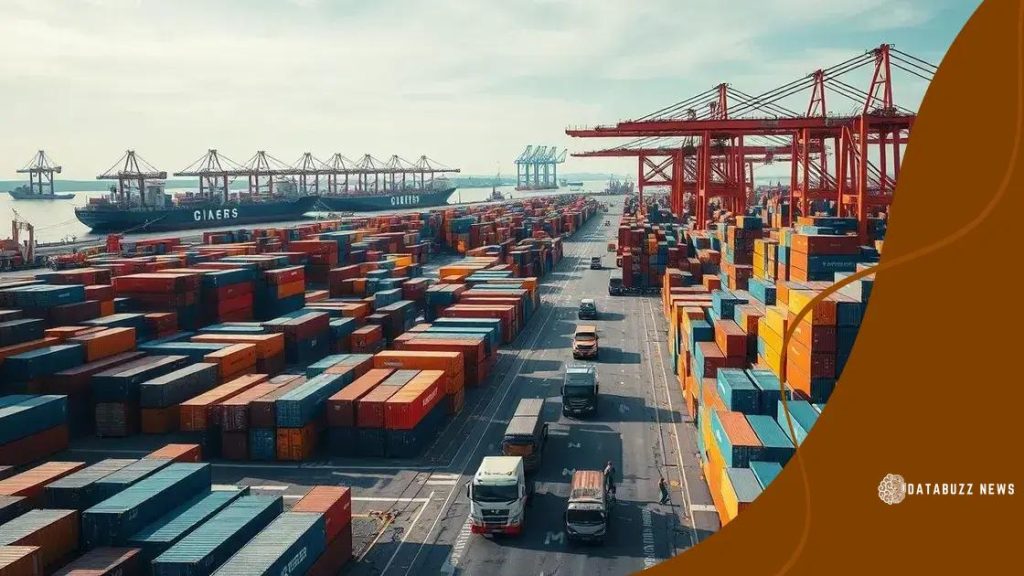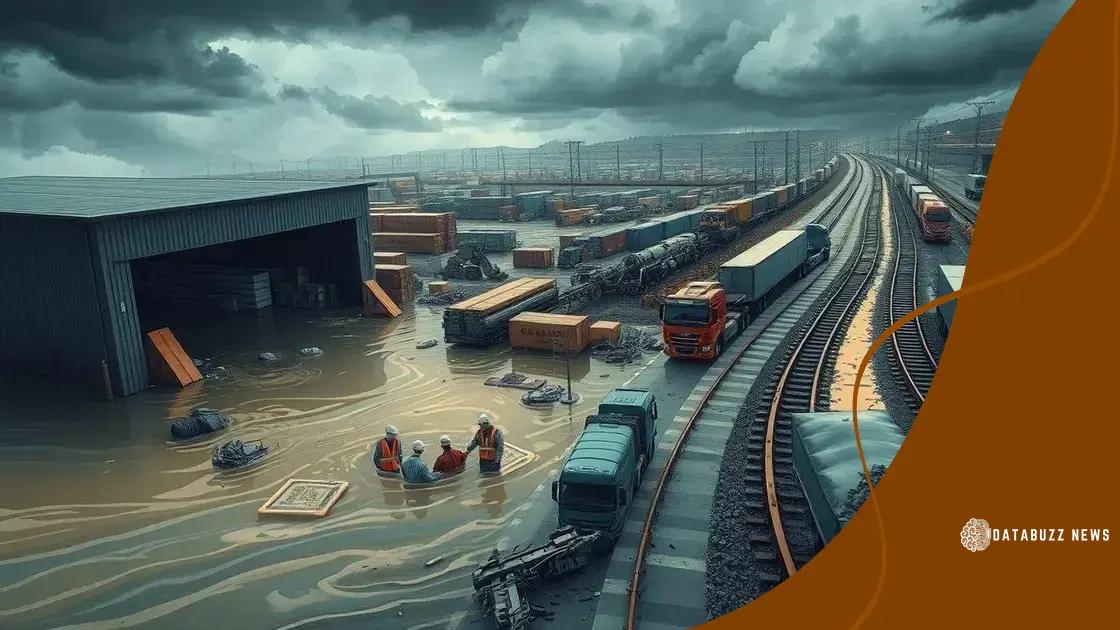Market disruptions tied to supply chain issues

Market disruptions tied to supply chain issues can significantly impact businesses, necessitating proactive strategies like technology adoption, supplier diversification, and sustainability practices to build resilience and maintain efficiency.
Market disruptions tied to supply chain issues are impacting businesses globally. Ever wondered how they affect your daily operations? In this article, we’ll delve into what’s causing these disruptions and how to address them effectively.
Understanding supply chain disruptions
Understanding supply chain disruptions is essential in today’s fast-paced economy. Businesses face challenges that can arise from various factors, impacting operations and profitability.
Multiple forces can disrupt supply chains. Some are due to natural events, while others stem from economic shifts globally. Identifying these disruptions can help businesses adapt efficiently.
Types of Supply Chain Disruptions
There are a few common types of disruptions that businesses frequently encounter.
- Natural disasters: Earthquakes, floods, and hurricanes can halt production.
- Political instability: Changes in government or policies can affect trade agreements.
- Market demands: Sudden shifts in consumer preferences may lead to shortages.
- Supplier issues: A supplier’s failure to deliver can create a domino effect.
By recognizing these challenges, companies can formulate strategies to mitigate risks. For instance, diversifying suppliers is a proactive measure to alleviate potential bottlenecks. Additionally, companies might invest in technology to enhance supply chain visibility.
Impact of Disruptions
The impact of disruptions goes beyond immediate supply shortages. Prolonged disruptions can lead to customer dissatisfaction and potential financial losses. Companies often struggle with increased operational costs as they scramble to source materials or find alternative solutions.
Another facet to consider is how these disruptions affect relationships with consumers. Trust is built over time, and a single disruption may tarnish a brand’s reputation. It’s critical for businesses to communicate transparently with their customers about potential delays or changes.
Overall, understanding supply chain disruptions equips businesses to respond more rapidly and effectively. This knowledge not only aids in immediate problem-solving but also positions companies for long-term success by fostering resilience against future disruptions.
Key factors impacting supply chains
Key factors impacting supply chains are critical to understand for effective management. Various elements can either enhance or hinder the flow of goods from production to consumers.
One major factor is global economic conditions. Changes in economies can ripple through supply chains, affecting everything from pricing to availability of materials. When economies face downturns, demand may drop, leading to excess inventory and financial strain.
Political and Regulatory Influences
Political situations and regulations also play a large role. Trade policies can affect tariffs, which directly impact costs.
- Tariffs and trade agreements: Changes here can suddenly increase costs.
- Customs regulations: Stricter rules can delay shipments.
- Labor laws: These can impact available workforce.
- Geopolitical tensions: Situations like conflicts can disrupt trade routes.
Another key factor is technological advancements. Companies that leverage technology for automation and data analysis tend to perform better. Automation speeds up production, while data analytics help forecast demand more accurately.
Consumer behavior is a significant consideration as well. Today’s consumers expect fast delivery and high-quality products. Failure to meet these expectations can lead to dissatisfaction and lost sales. Businesses must adapt their supply chains to align with changing consumer preferences.
In summary, understanding the key factors impacting supply chains enables businesses to navigate challenges and create robust strategies. By staying informed and agile, companies can thrive even in uncertain environments.
Real-world examples of disruptions

Real-world examples of disruptions provide insight into how unforeseen events can affect supply chains. By examining these scenarios, businesses can learn valuable lessons and adapt their strategies.
One notable example occurred during the COVID-19 pandemic. As countries implemented lockdowns, manufacturing facilities slowed down or shut down entirely. This caused significant delays in product availability, leaving retailers scrambling to meet consumer demand.
Natural Disasters
Natural disasters also pose significant threats to supply chains. For instance, Hurricane Katrina in 2005 disrupted transportation and logistics in the Gulf of Mexico.
- Damage to warehouses: Many facilities were flooded or destroyed.
- Transportation issues: Roads and bridges were damaged, delaying shipments.
- Local economies: Businesses were affected, leading to wider economic problems.
Another example is the earthquake in Japan in 2011, which halted production for many companies. Electronics manufacturers like Sony and Toyota faced severe delays as their supply chains were disrupted due to damaged infrastructure.
Additionally, political disruptions can affect global trade. The trade tensions between the U.S. and China led to tariffs that increased costs and forced many companies to rethink their supply chain strategies. Some businesses sought alternative suppliers in other countries to mitigate risks associated with relying on a single source.
These real-world examples highlight the importance of being prepared for supply chain disruptions. Understanding past events helps businesses develop responsive plans and maintain resilience in uncertain circumstances.
Strategies for mitigating supply chain risks
Strategies for mitigating supply chain risks are essential for businesses to thrive despite challenges. A proactive approach can help companies safeguard their operations and maintain customer satisfaction.
One effective strategy is to diversify suppliers. Relying on a single supplier can be risky, especially during disruptions. By engaging multiple suppliers for key materials, businesses can ensure a steady flow of goods even if one supplier faces challenges.
Investing in Technology
Technology also plays a crucial role in risk mitigation. Implementing supply chain management software can improve visibility and enhance decision-making.
- Real-time tracking: Companies can monitor inventory levels and shipments to respond quickly to potential issues.
- Data analytics: Analyzing data helps forecast demand accurately and anticipate potential disruptions.
- Automation: Automating processes can reduce human errors and increase efficiency.
Another vital strategy is to build strong relationships with suppliers. Open communication fosters collaboration, making it easier to address issues as they arise. When suppliers know their customers’ needs and expectations, they are better equipped to respond promptly.
Risk assessment is also a key part of mitigating supply chain risks. Regularly evaluating potential risks, including natural disasters or political factors, allows businesses to develop contingency plans. By understanding vulnerabilities, companies can create targeted strategies to manage them effectively.
Finally, businesses should consider investing in sustainable practices. Adopting environmentally friendly practices can improve resilience and appeal to conscious consumers. Sustainable sourcing and logistics can reduce reliance on fluctuating resources.
Future outlook on supply chain management
The future outlook on supply chain management indicates exciting developments driven by technology and changing market demands. As businesses adapt, they can create more resilient and efficient supply chains.
One key trend is the increased use of artificial intelligence (AI). AI can help companies predict demand and optimize logistics. By analyzing vast amounts of data, organizations can make informed decisions that enhance efficiency.
Emphasis on Sustainability
Sustainability will also take center stage in supply chain management. More companies are recognizing the need for eco-friendly practices. This shift toward sustainable sourcing can lead to significant cost savings and improve brand loyalty.
- Green logistics: Implementing sustainable transportation methods reduces carbon footprints.
- Ethical sourcing: Ensuring materials are sourced responsibly appeals to conscious consumers.
- Waste reduction: Streamlining processes to minimize waste will be prioritized.
Digital transformation is another crucial aspect of the future landscape. Technologies like the Internet of Things (IoT) and blockchain will provide better tracking and transparency. IoT devices can monitor inventory levels in real time, while blockchain offers secure documentation of transactions.
The growing importance of e-commerce is reshaping supply chains as well. More consumers are shopping online, driving companies to adapt their delivery systems. Fast, reliable shipping options will become essential to meet customer expectations.
Collaboration across industries will enhance resilience. Sharing information and resources can help businesses navigate disruptions more effectively. By learning from each other, companies can build stronger, more adaptive chains.
FAQ – Frequently Asked Questions about Supply Chain Management
What are supply chain disruptions?
Supply chain disruptions are interruptions that affect the flow of goods and services, often due to events like natural disasters, political changes, or global pandemics.
How can technology help mitigate supply chain risks?
Technology can enhance visibility and efficiency in supply chains through tools like AI, IoT, and data analytics, enabling companies to anticipate and respond to disruptions.
Why is sustainability important in supply chain management?
Sustainability is important because it reduces environmental impact, improves brand reputation, and appeals to increasingly eco-conscious consumers.
What strategies can companies use to build resilience?
Companies can build resilience by diversifying suppliers, fostering strong relationships, leveraging technology, and regularly assessing potential risks to adapt swiftly.
